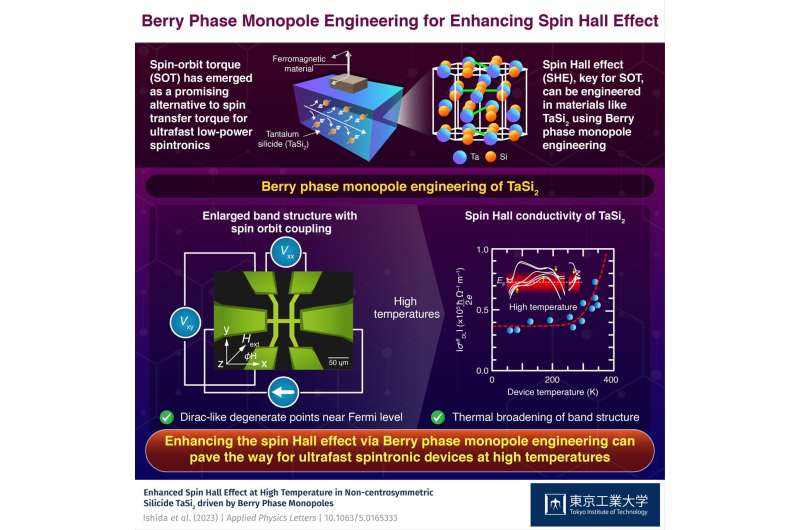This article has been reviewed according to Science X's editorial process and policies. Editors have highlighted the following attributes while ensuring the content's credibility:
fact-checked
peer-reviewed publication
trusted source
proofread
Using Berry phase monopole engineering for high-temperature spintronic devices

Spintronic devices are electronic devices that utilize the spin of electrons (an intrinsic form of angular momentum possessed by the electron) to achieve high-speed processing and low-cost data storage. In this regard, spin-transfer torque is a key phenomenon that enables ultrafast and low-power spintronic devices. Recently, however, spin-orbit torque (SOT) has emerged as a promising alternative to spin-transfer torque.
Many studies have investigated the origin of SOT, showing that in non-magnetic materials, a phenomenon called the spin Hall effect (SHE) is key to achieving SOT. In these materials, the existence of a "Dirac band" structure, a specific arrangement of electrons in terms of their energy, is important to achieving large SHE. This is because the Dirac band structure contains "hot spots" for the Berry phase, a quantum phase factor responsible for the intrinsic SHE. Thus, materials with suitable Berry phase hot spots are key to engineering the SHE.
In this context, the material tantalum silicide (TaSi2) is of great interest as it has several Dirac points near the Fermi level in its band structure, suitable for practicing Berry phase engineering. To demonstrate this, a team of researchers, led by Associate Professor Pham Nam Hai from the Department of Electrical and Electronic Engineering at Tokyo Institute of Technology (Tokyo Tech), Japan, recently investigated the influence of Dirac band hot spots on the temperature dependence of SHE in TaSi2.
"Berry phase monopole engineering is an interesting avenue of research as it can give rise to efficient high-temperature SOT spintronic devices such as the magneto-resistive random-access memory," says Dr. Hai. Their findings were published in the journal Applied Physics Letters.
Through various experiments, the team observed that the SOT efficiency of TaSi2 remained almost unchanged from 62 K to 288 K, which was similar to the behavior of conventional heavy metals. However, upon increasing the temperature further, the SOT efficiency suddenly increased and nearly doubled at 346 K. In addition, the corresponding SHE also increased in a similar fashion.
Notably, this was quite different from the behavior of conventional heavy metals and their alloys. Upon further analysis, the researchers attributed this sudden increase in SHE at high temperatures to Berry phase monopoles.
"These results provide a strategy to enhance the SOT efficiency at high temperatures via Berry phase monopole engineering," says Dr. Hai.
Their study highlights the potential of Berry phase monopole engineering to effectively use the SHE in non-magnetic materials, and provides a new pathway for the development of high-temperature, ultrafast, and low-power SOT spintronic devices.
More information: Ken Ishida et al, Enhanced spin Hall effect at high temperature in non-centrosymmetric silicide TaSi2 driven by Berry phase monopoles, Applied Physics Letters (2023). DOI: 10.1063/5.0165333
Journal information: Applied Physics Letters
Provided by Tokyo Institute of Technology





















